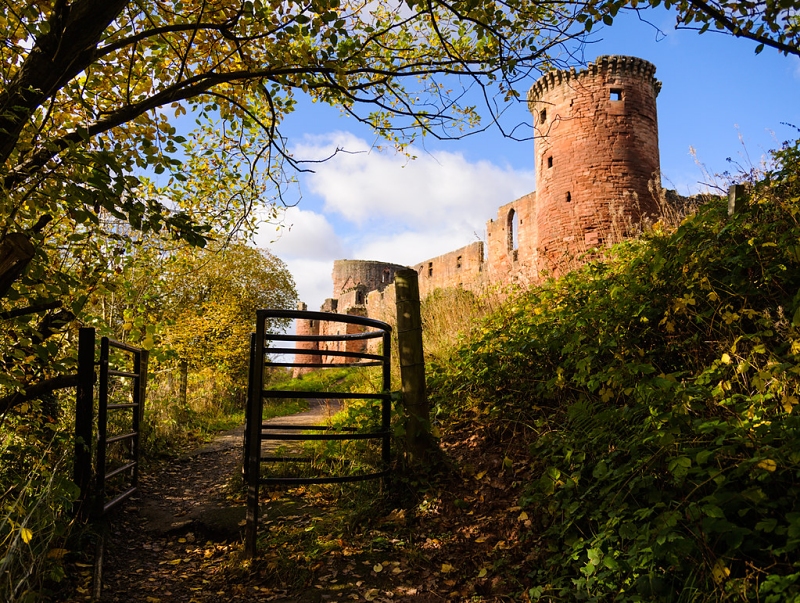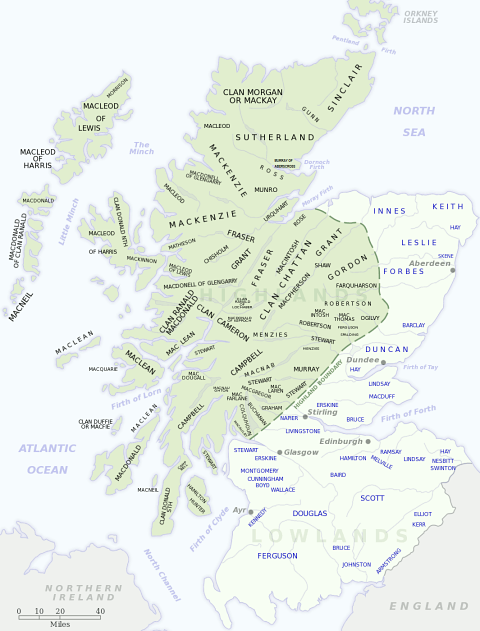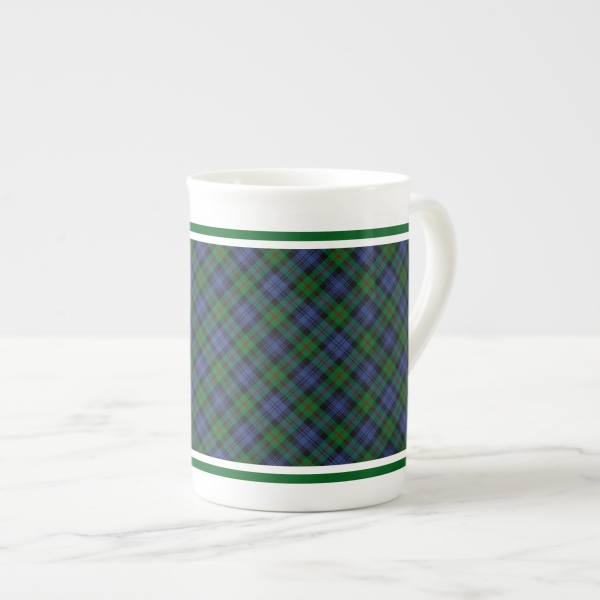
Motto: Furth fortune and fill the fetters
Historic Seat: Bothwell Castle
District: Atholl, Lanarkshire
Associated Surnames: Balneaves, Butter, Corson, Fleming, MacKinnoch, MacMurray, Moncreiffe, Moray, Morrow, Neaves, Pepper, Piper, Rattray, Small, Smalley, Spaden, Spalding
Associated Tartans:
Early Murray Genealogy and History:
(Excerpt from "The Scottish Clans and Their Tartans", James Grant, 1906)
Without adopting the vague account of the origin of this clan, the family is said to be descended from Freskin, who owned land in Morayshire in the twelfth century. His descendant, Sir John de Moravia, was a man of importance in the reigns of William the Lion and Alexander II. He settled in Perthshire, and died about 1225, leaving a son, Sir Malcolm, and also a brother, Sir Gilbert, who was consecrated Bishop of Caithness in 1222, and died in 1245.
Sir William the son of Sir Malcolm, succeeded his father in 1236, and acquired the lands of Tullibardine by marriage. He was one of the Magnates Scotiae summoned to Berwick in 1296 by Edward I of England. His son, Sir Andrew, assisted Edward Baliol, and was present at the battle of Dupplin,1 where he was taken prisoner, and executed 1332.
His successors in the direct line were Sir William Sir John, Walter (died 1390), and Sir David. Sir David died 1453, leaving several sons - William, his successor; Patrick, ancestor of Murrays of Ochtertyre; James, ancestor of the Murrays of Strowan; and Alexander, ancestor of the Murrays of Tibbermore. From the eldest son, William, who married a daughter of Sir John Stewart, Earl of Atholl, and died 1524; William, who died 1562; Sir William, who was father of Sir John Murray, who was Master of the Household to King James VI, and was created Earl of Tullibardine, 1606. He died 1609, and was succeeded by his son William, second Earl, who married the eldest daughter of John Stewart, fifth Earl of Atholl, and resigned the Earldom of Tullibardine, which was afterwards conferred on his younger brother, Patrick, in 1628.
William, second Earl, died in 1626, and was succeeded by his son John, who was in 1628 confirmed as Earl of Atholl. He was taken prisoner by the Earl of Argyll during the civil war, and died 1642. His son, John, second Earl of Atholl, was keeper of the Privy Seal, and succeeded his cousin James in 1670 as Earl of Tullibardine. In 1676 he was created Marquis of Atholl, and was one of the original Knights of the Thistle. He died 1703, and was succeeded by his son John, who was a supporter of King William III, was afterwards Lord Privy Seal, and was created Duke of Atholl in 1703. He opposed the Union with England, and died 1724. Of his children, John, the eldest, was killed at Malplaquet in 1709; William, the second son, as Marquis of Tullibardine, with the fifth son, George, joined Prince Charles Edward. He surrendered, and was committed to the Tower, where he died in 1746; James, the third son, succeeded to the Dukedom, and died 1764, being succeeded by his nephew John, son of his brother George.
He sold the sovereignty of the Isle of Man to the Government for £70,000, and a pension, and died 1774, being succeeded by his son John, fourth Duke, who died 1830, leaving two sons, John, fifth Duke, died 1846, and James, Lord Glenlyon, father of George, sixth Duke, who died 1864, and was succeeded by John, seventh and present Duke of Atholl.
The Viscounts Stormont, who later became Earls of Mansfield, are descended from Sir Andrew Murray, second son of Sir William Murray of Tullibardine, who died about 1511. The present representative is William, fifth Earl of Mansfield and tenth Viscount Stormont.
The Earls of Dunmore are descended from John, first Marquis of Atholl.
Eleven baronetcies have belonged to the powerful clan of the Murrays. In 1626 Sir William Murray of Clermont, a cadet of the family of Blackbarony, was created a Bart.2 of Nova Scotia; Sir Archibald Murray of Blackbarony, Bart. in 1728; Sir William Murray of Dunerne, Bart., 1630 (extinct); Sir William Murray of Abirmont, Bart., 1631 (extinct); Sir William Murray of Stanhope, Bart., 1664; Sir William Murray of Octertyre, Bart., 1673; Sir Thomas Murray of Glendoick, Bart. 1776; and Alexander, Count Murray of Melgum, Bart., 1704.
Sir Robert Murray of Craigie, one of that small but learned group who founded the Royal Society in 1662, died in 1673. When his daughter was married to Lord Yester in London, Charles II "himself led the bride, uncovered, to church." William Murray, the first Earl of Mansfield, the famous lawyer and statesman, was the fourth son of the fifth Viscount Stormont, and was born in Perth in 1705. In 1754 he succeeded Sir Dudley Rider as Attorney-General, became a member of the Cabinet and Chancellor of the Exchequer. During the Gordon Riots3 his house in London was fired by the mob. Infirmities compelled him to resign the office of Lord Chief Justice in 1778. He died at his seat, called Caen Wood, near Hampstead, in 1793, and was buried in Westminster Abbey.
(End excerpt)
Next page: Clan Ogilvie
Footnotes:
1 The Battle of Dupplin Moor (1332): The Battle of Dupplin Moor was fought 10-11 August, 1332, near Perth, Scotland between supporters of the infant David II, son of Robert the Bruce, and rebels supporting the Baliol claim to the throne. It was a significant battle of the Second War of Scottish Independence. Read more about the Battle of Dupplin Moor at Wikipedia.
2 Bart.: Baronet
3 Gordon Riots: The Gordon Riots of 1780 began with a large (40,000-60,000 crowd) orderly protest in London against the Papists Act of 1778, during which Lord George Gordon, head of the Protestant Association, presented a petition to the House of Commons warning that the law would enable Catholics in the British Army to become a dangerous threat. The protest evolved into several days of widespread rioting and looting. Read more about the Gordon Riots at Wikipedia.

Distribution of Scottish clans and families
View larger map at Wikimedia Commons

Browse the Clan Murray Tartan Collection with home decor, personal accessories, crafting, paper products, and more.

Browse the Atholl District Tartan Collection with clothing, home decor, accessories, electronics cases, and more.